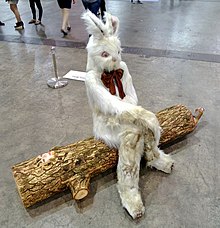Marnie Weber
Marnie Weber (born 1959) is an American artist who lives and works in Los Angeles. Her work includes photography, sculpture, installations, film, video, and performances. She is also a musician.[1]
Marnie Weber | |
|---|---|
| Born | 1959 |
| Nationality | American (United States) |
| Education | University of Southern California, University of California |
| Known for | sculpture, film, photography |
Life and work
Marnie Weber was born in Bridgeport, Connecticut, U.S. and spent part of her childhood moving around Asia with her family.[2] She studied at the University of Southern California, Los Angeles, CA, and received her B.A. from University of California, Los Angeles.[3] She has had solo shows, video screenings, and performances throughout the United States and Europe.

Much of Weber's visual art revolves around a recurring cast of characters. An animal often found in her work is the bear, which is linked to the Greek goddess Artemis.[4] These characters, among others, are placed in "vividly colorful environment[s]",[5] ornate, Empire style interiors or dark, dense, eerie landscapes. Her work most often focuses on the adventures of women, which sometimes take the form of half-human, half-animal hybrids with bodies cut from pornographic magazines, and other times, pale-faced, folksy ghosts known as "Spirit Girls".[6]
Marnie Weber's work is featured on the cover of the 1998 Sonic Youth album A Thousand Leaves.[7]
The Spirit Girls was the name of Marnie Weber's six member drone-rock musical group. The Spirit Girls is also the name of Weber's multimedia conceptual project which used film, sculpture, collage, installation and performance to explore the after-life of the all-female rock band featured in four Weber films: Songs that Never Die (2005), A Western Song (2007), The Sea of Silence (2009) and Eternity Forever (2010).[2] In the films, the Spirit Girls "are the specters of five adolescents, killed in their prime, who come back to the real world to 'express things they weren't able to express' while they were alive."[8] The spectral Spirit Girls are said to have died tragically in the male-dominated music scene of the 1970s. The opening of the final film in the series, Eternity Forever, was held at the Mountain View Mausoleum in Altadena, CA, built with a gallery for temporary art exhibits. The opening also featured the living Spirit Girls, who played their final concert to 500 equally alive attendees.[2]
Weber has also performed and recorded with The Party Boys (US-band) and The Perfect Me. She has two solo albums, Woman with Bass, 1994 and Cry for Happy, 1996, both recorded as "Marnie". In 2004, a compilation of her work was released entitled Songs Forgotten: The Best of Marnie 1987 - 2004.[9]
In 2016 Weber released a feature-length film, The Day of Forevermore, which she wrote and directed and features her artwork.[10][11]
She is married to the Los Angeles-based artist Jim Shaw.
Her work has been associated with New Gothic Art.[12]
Collections
- Museum of Contemporary Art, Los Angeles, CA, US
- Los Angeles County Museum of Art, Los Angeles, CA, US
- Neuberger Berman Inc., New York, NY, US
- Progressive Corporation, Mayfield, OH, US
- Fond National d'Art Contemporain (FNAC), FR [13]
- MAMCO, Geneva, Switzerland
- Hammer Museum, Los Angeles
Notes and references
- http://marnieweber.com/Bio.html
- Yablonsky, L (November 23, 2010). "New York Times Style Magazine. Artifacts: Ghost Dance". Article.
- http://www.simonleegallery.com/press-pdfs/mw_press_saatchi_online_magazine_june_2011.pdf%5B%5D Saatchi Online Magazine, "Interview with Marnie Weber, Amy Greenberg, June 3, 2011
- Kristina Newhouse, "Girls Gone Wild," X-TRA, Volume 10 Number 2, Winter 2007, p. 21
- Julie Joyce, "Too Fast to Live, Too Young to Die" in "Marnie Weber: From the Dust Room" catalogue, Harriet and Charles Luckman Fine Arts Complex, Cal State University, Los Angeles, 2005, p. 7
- Kerek, Rowan (September 10, 2004), "Animal women at London's Emily Tsingou Gallery", BBC Collective, BBC, archived from the original on November 12, 2012
- "Interview with Marnie Weber". The White Review. Retrieved 2020-02-26.
- Harvey, Doug (August 11, 2005). "Spirits rock among us: A studio visit with Marnie Weber". LA Weekly. Retrieved June 1, 2019.
- "Discography", Marnie Weber
- Swann, Jennifer (November 4, 2016), Is There Room in the Fine Art World for Marnie Weber's Monsters?, LA Weekly, retrieved June 1, 2019
- The Day of Forevermore (2016), Internet Movie Database
- Gavin, Francesca. Hell Bound: New Gothic Art. London: Laurence King Publishing, 2008.
- http://www.praz-delavallade.com/artists/Marnie_Weber/biography.html?from=artist_id#13
Further reading
- References for all exhibitions, screenings, and performances
- Christopher Miles, "Marnie Weber at Patrick Painter Inc," Artforum, XLVI, No. 1, September 2007, pp. 477–478
- Ute Thon. "Gemischtwarenladen der Gehobenen Klasse," Art Das Kunstmagazin, October 2007.
- Micol Hebron. "Critic's Picks Los Angeles: Marnie Weber," Artforum.com, May 2007.
- Mary Barone. "Out at Frieze," Artnet.com, October 2007.
- Hunter Drohojowsha-Philpr. "That's The Spirit," Artnet.com, May 23, 2007.
- Annie Buckley. "Spirit Girl," Craft: transforming traditional crafts, Vol. 04, 2007, pp. 60–62
- "Fantasy Freaky: Marnie Weber," Dazed & Confused, April, 2007